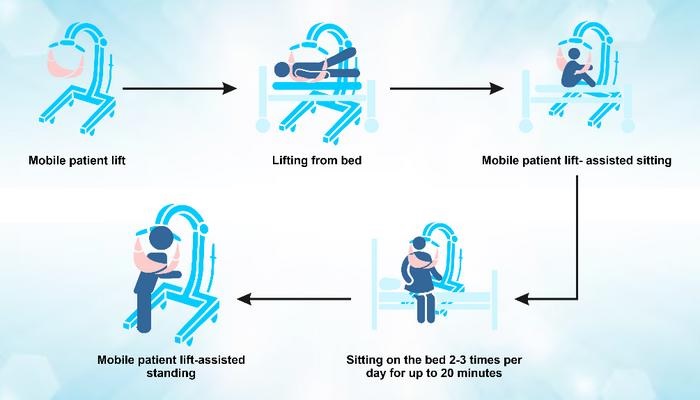Highlights Ask: The objective of this study was to determine whether a mobile patient lift facilitates early mobilization (EM) and improves physical function in ventilated ICU patients. Findings: The use of mobile lifts for mechanically ventilated ICU patients may improve their physical function during ICU admission by accelerating the process of standing. Meaning: The findings of this study could contribute to the development of more effective approaches for MS in the ICU. |

Figure: The use of mobile lifts for mechanically ventilated ICU patients improves their physical function during ICU admission by accelerating the standing process. The intervention group remained predominantly faster than the control group. The intervention group also had significantly higher ICU functional status scores at ICU discharge.
Comments
A recent randomized controlled trial conducted in Tokyo, Japan, has revealed the positive impact of early mobilization, assisted by mobile lifts on the recovery of intensive care unit (ICU) patients. Debate about the effectiveness of early mobilization in the ICU has persisted for a long period.
Treatment of critically ill patients in ICUs, often involving prolonged limb immobilization or restricted mobility, is recognized as a risk factor for decreased physical strength and quality of life after recovery, commonly called post-intensive care syndrome (PICS) or acquired weakness (UCI-AW). Although early mobilization, the initiation of physical activity in the early stages of ICU treatment, has been suggested as a preventive measure for acquired weakness (ICU-AW), its impact on outcomes has been highly controversial. This new study aimed to investigate whether a more proactive approach to early mobilization, assisted by mobile patient lifts, could facilitate mobilization compared to usual rehabilitation.
The study involved 80 patients who received assisted ventilation for a minimum of 48 hours. The intervention group received assistance with sitting, standing, transferring, and walking using a mobile patient lift.
The researchers observed that the use of mobile lifts led to earlier standing (on day 1, compared to day 3 in the control group after the start of rehabilitation). Additionally, the intervention group showed a higher functional status score for Intensive Care Unit (FSS-ICU) scores at ICU discharge and physical function during the ICU stay.
This study highlights the benefits of early mobilization for mechanically ventilated ICU patients when combined with the use of mobile patient lifts. Given the historical controversy surrounding the effectiveness of early mobilization, these findings may contribute to our understanding of the recovery process in ICU patients.
"We anticipate that proactive early mobilization, with the aid of mobile patient lifts, will play a critical role in the prevention of post-intensive care syndrome. To obtain conclusive evidence on the advantages of early mobilization, further studies must be conducted to accumulate data to support it," said Dr. Ginga Suzuki, lead author of the study.
Discussion
This RCT tested whether the mobile patient lift facilitates early mobilization (EM) of mechanically ventilated ICU patients. The use of mobile patient lifts resulted in earlier standing and a higher ICU Functional Status Score (FSS-ICU), which was associated with better physical function at discharge, highlighting the importance of MS using mobile patient lifts.
This study is the first RCT to confirm that mobile patient lifts facilitate MS in mechanically ventilated ICU patients. We believe that mobile patient lifts facilitate the mobilization of mechanically ventilated ICU patients for three reasons:
- First, they can achieve patient mobilization that would be impossible with human power alone. Applying a vertical force to a seated patient with human power alone can be difficult due to the position and space of medical personnel.
- Secondly, even if the patient does not have the muscle strength to get up from a sitting position, a mobile patient lift can allow the patient to stand and maintain their posture. If the muscles are not strong enough and the knees bend, human knee support is necessary. However, once the patient is standing, it is often possible to maintain the posture.
- Third, the mobile patient lift can provide patients with a sense of security. No patients in the mobile patient lift group fell.
Improvement in FSS-ICU with the use of mobile patient lifts may result from early standing and possible strengthening of the erector spinae and other trunk muscles. Kindreds et al reported that standing activates the neuromuscular network involved in postural muscles, and achieving standing from an early period can result in coordination of postural muscles, improving FSS-ICU.
Conclusions The use of mobile lifts for mechanically ventilated ICU patients may improve their physical function during hospitalization by accelerating the process of standing. The results should be validated in studies designed to have a lower risk of bias. Security verification is also required. |















